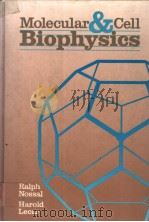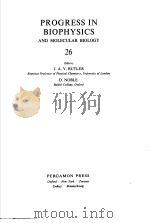《Molecular Biophysics》
| 作者 | Richard B.Setlow and Ernest C. 编者 |
|---|---|
| 出版 | 未查询到或未知 |
| 参考页数 | |
| 出版时间 | 没有确切时间的资料 目录预览 |
| ISBN号 | 无 — 求助条款 |
| PDF编号 | 820174908(仅供预览,未存储实际文件) |
| 求助格式 | 扫描PDF(若分多册发行,每次仅能受理1册) |

CHAPTER 1.PHYSICS AND BIOLOGY1
1-1Introduction1
1-2 History of biophysics3
1-3 Life - order or chaos?6
1-4 Summary7
CHAPTER 2.THE BIOPHYSICIST'S VIEW OF THE LIVING CELL10
2-1The broad characteristics of a typical cell10
2-2 Cell organelles13
2-3 The molecular composition of a cell16
2-4 Biological molecules and their general character17
2-5 Cell behavior26
2-6 Viruses31
2-7 Genetics and biophysics36
2-8 Molecular biophysics38
CHAPTER 3.ENERGETIC AND STATISTICAL RELATIONS IN THE LIVING CELL42
3-1Introduction42
3-2 The conservation of energy in biological processes43
3-3 Metabolism,or chemical and energy turnover45
3-4 Statistical thermodynamics and biology49
3-5 The theory of absolute reaction rates57
3-6 Thermal inactivation62
3-7 The entropy transfer of living organisms63
3-8 Information theory.Relation between information and entropy66
3-9 Information content of some biological systems68
3-10 Information content of a bacterial cell71
CHAPTER 4.PHYSICAL METHODS OF DETERMINING THE SIZES AND SHAPES OF MOLECULES77
4-1Introduction77
4-2 Random motion79
4-3 Diffusion82
4-4 Measurement of diffusion constants87
4-5 Sedimentation91
4-6 Sedimentation-equilibrium method93
4-7 Sedimentation-velocity method95
4-8 Analytical centrifuges and optical detection methods98
4-9 Rotational diffusion and birefringence105
4-10 Conclusion109
CHAPTER 5.X-RAY ANALYSIS AND MOLECULAR STRUCTURES113
5-1Introduction113
5-2 Production of x-rays115
5-3 Diffraction of x-rays118
5-4 Crystal structure and the unit cell121
5-5 Layer lines and crystal arrays124
5-6 Vector representation of amplitudes and the width of diffraction maxima126
5-7 Density distribution within a unit cell128
5-8 The diffraction patterns of some protein fibers132
5-9 The structure of globular proteins135
5-10 The structure of polypeptide chains139
5-11 The pleated sheets and β-keratin141
5-12 The α-helix and α-keratin143
5-13 The structure of nucleic acid polymers145
5-14 The structure of nucleoproteins150
5-15 The analysis of virus structures151
5-16 Conclusion153
CHAPTER 6.INTRAMOLECULAR AND INTERMOLECULAR FORCES156
6-1Strong and weak forces156
6-2 The uncertainty principle and the Pauli principle157
Ⅰ.Strong Interactions161
6-3The covalent bond161
6-4 The ionic bond163
6-5 Resonance164
Ⅱ.Weak Interactions165
6-6Dipole-dipole interaction165
6-7 Permanent-dipole,induced-dipole interaction169
6-8 Transient-dipole,induced-dipole interaction170
6-9 Dispersion forces between large molecules172
6-10 The hydrogen-bond interaction174
6-11 Charge-fluctuation interaction175
Ⅲ.molecules in Solution176
6-12Debye-Hückel theory176
6-13 Antigens and antibodies as examples of short-range forces in solution181
CHAPTER 7.ABSORPTION SPECTROSCOPY AND MOLECULAR STRUCTURE189
7-1Introduction189
7-2 Atomic energy levels190
7-3 Molecular energy levels193
7-4 Vibrational energy levels195
7-5 Vibrations of polyatomic molecules199
7-6 Characteristic bond frequencies201
7-7 Raman spectra and the dipolar nature of amino acids203
7-8 The vibrational spectra of proteins205
7-9 The energy levels of hydrogen-bonded structures206
7-10 Absorption coefficient and cross section208
7-11 Experimental techniques for absorption measurements212
7-12 Absorption by oriented dipoles214
7-13 Dichroic ratios of proteins and nucleic acids217
7-14 Electronic energy levels220
7-15 Electronic spectra of polyatomic molecules223
7-16 Ultraviolet absorption by proteins and nucleic acids225
7-17 The fine structure in spectra228
7-18 Polarized ultraviolet light229
7-19 Electron spin resonance230
7-20 Nuclear magnetic resonance234
CHAPTER 8.ENZYMES239
8-1Introduction239
8-2 The temperature dependence of enzyme kinetics239
8-3 The enzyme-substrate complex242
8-4 Observation of the enzyme-substrate complex245
8-5 Heat inactivation and the structure of enzymes251
8-6 The relation between enzyme structure and function253
8-7 Enzyme specificity257
8-8 Speculations about the mechanism of enzyme action262
8-9 Speculations about the minimum size of an enzyme264
CHAPTER 9.ACTION SPECTRA AND QUANTUM YIELDS267
9-1Introduction267
9-2 Light sources and materials269
9-3 Monochromators271
9-4 Intensity measurements274
9-5 Definition of action spectra277
9-6 Action spectra theory278
9-7 Inactivation of proteins and nucleic acids281
9-8 Light action on respiratory pigments288
9-9 Photosynthesis291
9-10 Sensitized fluorescence294
9-11 Viruses and microorganisms295
9-12 Cooperative events in light action;the Poisson distribution296
9-13 Photoreversal303
CHAPTER 10.THE ACTION OF IONIZING RADIATION ON CELLULAR CONSTITUENTS306
10-1Introduction306
10-2 The nature of ionizing radiation307
10-3 The measure of radiation:the roentgen315
10-4 Ionization by x-rays,gamma rays,or neutrons315
10-5 Dosimetry318
10-6 Action of ionizing radiation on molecular systems321
10-7 Experimental results of bombarding large biological molecules323
10-8 Target theory326
10-9 Variable linear energy transfer328
10-10 Effect of secondary electrons,or delta rays331
10-11 Features of the radiation sensitivity of large molecules333
10-12 Molecular effects by agents that diffuse334
10-13 Protective action against diffusing agents336
10-14 The oxygen effect338
10-15 A theoretical analysis of radiation effects on a cell339
10-16 The action of ionizing radiation on chromosomes343
10-17 The effects of ionizing radiation on human beings347
CHAPTER 11.THE USE OF IONIZING RADIATION TO STUDY CELL STRUCTURE352
11-1Introduction352
11-2 The principle of the method352
11-3 Early radiation studies of structure356
11-4 Radiation studies of the structure of viruses358
11-5 Differential radiation studies on bacteria366
11-6 Bombardment of bacteria by particles limited in penetration374
11-7 Orientation studies377
11-8 Conclusion378
CHAPTER 12.MICROSCOPES380
12-1Introduction380
12-2 Magnification380
12-3 Resolution384
12-4 Contrast391
12-5 Staining393
12-6 Fluorescence393
12-7 Polarization393
12-8 Ultraviolet microscopes396
12-9 Interference microscopes399
12-10 Phase microscopes403
12-11 Electron microscopy410
CHAPTER 13.ISOTOPIC TRACERS IN MOLECULAR BIOPHYSICS417
13-1Introduction417
13-2 Detection and measurement of isotopes420
13-3 Experimental use of isotopic tracers424
13-4 The permeability of the bacterial cell to small molecules424
13-5 Amino acid incorporation;isotopic competition426
13-6 The induction of adaptive enzymes432
13-7 Effect of incorporated phosphorus-32 on the viability of a bacterial virus434
13-8 Radioautographic studies of biological duplication436
13-9 Remarks about commonly used isotopes443
13-10 Summary and conclusion446
CHAPTER 14.MOLECULAR BIOPHYSICS AND MUSCLE,NERVE,AND EYE STUDIES448
14-1Introduction448
Ⅰ.Muscle Studies449
14-2Muscle fiber as a model449
14-3 Biochemical character of muscle451
14-4 The molecular architecture of the muscle fiber454
14-5 Muscle behavior456
14-6 Molecular biophysics and muscle action458
Ⅱ.Nerve Studies467
14-7Cell membranes467
14-8 Electrical effects associated with membranes469
14-9 Nature of a nerve and a nerve cell474
Ⅲ.Studies of the Eye479
14-10The eye as a model479
14-11 The retina480
14-12 Quantum nature of vision483
14-13 The biochemistry of retinal detection485
Ⅳ.Conclusion487
CHAPTER 15.THE PHYSICS OF CELLULAR PROCESSES489
15-1Introduction489
15-2 Growth489
15-3 Protein synthesis494
15-4 Random collison and specific selection495
15-5 Content of the volume around a ribosome496
15-6 Random collisions and the rates of each step in synthesis497
15-7 Temporary complex formation501
15-8 The speed of diffusion in the cell502
15-9 Electrical effects in diffusion504
15-10 Specificity of transport509
15-11 Fluctuations in the cell511
15-12 The duplication of DNA512
15-13 Random diffusion and specific selection in DNA synthesis513
15-14 The formation of ribosomes518
15-15 "Long-range"forces519
15-16 The process of cell division520
15-17 Conclusion522
ANSWERS TO SELECTED PROBLEMS525
CONVERSION TABLE527
INDEXES531
《Molecular Biophysics》由于是年代较久的资料都绝版了,几乎不可能购买到实物。如果大家为了学习确实需要,可向博主求助其电子版PDF文件。对合法合规的求助,我会当即受理并将下载地址发送给你。
高度相关资料
-

- PROGRESS IN BIOPHYSICS AND MOLECULAR BIOLOGY 14
- 1964 PERGAMON PRESS
-

- PROGRESS IN BIOPHYSICS AND MOLECULAR BIOLOGY 13
- 1963 PERGAMON PRESS
-

- PROGRESS IN BIOPHYSICS AND MOLECULAR BIOLOGY VOLUME 43
- PERGAMON PRESS
-

- MOLECULAR AND CELL BIOPHYSICS
- ADDISON-WESLEY PUBLISHING COMPANY
-

- PROGRESS IN BIOPHYSICS AND MOLECULAR BIOLOGY 26
- PERGAMON PRESS
提示:百度云已更名为百度网盘(百度盘),天翼云盘、微盘下载地址……暂未提供。➥ PDF文字可复制化或转WORD








